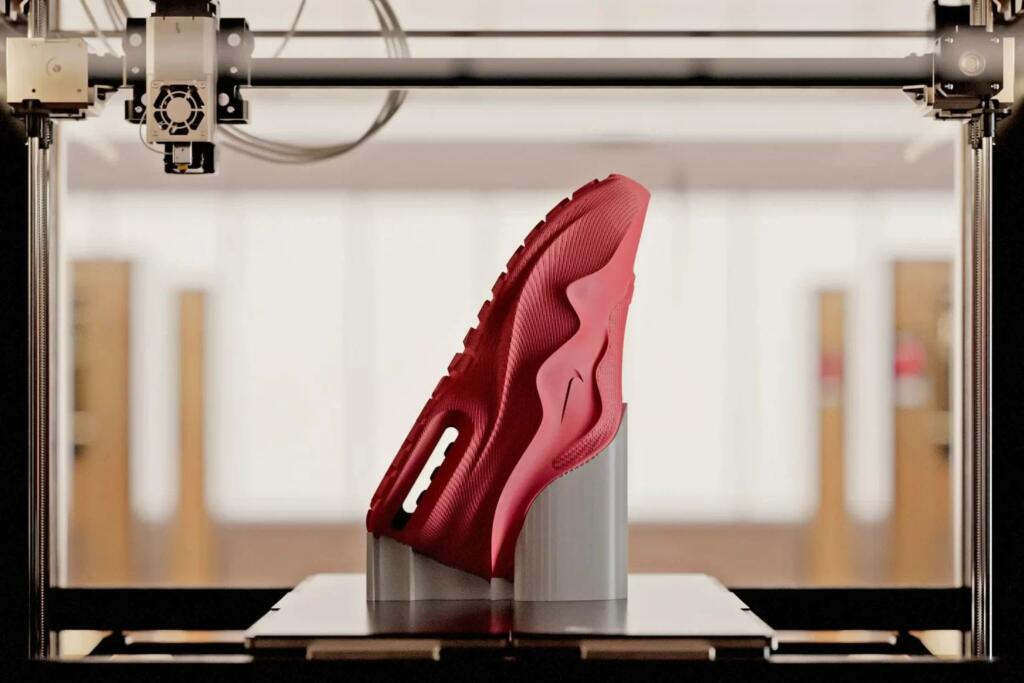Nike has taken a significant leap forward in footwear innovation with the approval of a new patent for advanced 3D printing technology. The patent underscores the company’s commitment to integrating additive manufacturing into its production processes, potentially revolutionizing the design, customization, and sustainability of athletic footwear. This development marks an important milestone in the company’s ongoing efforts to remain at the forefront of sportswear technology.
Table of Contents
What the Patent Covers
The newly secured patent focuses on the use of 3D printing for producing complex shoe components, allowing for intricate design patterns that are difficult or impossible to achieve through traditional manufacturing methods. The technology aims to enhance structural efficiency, reduce material waste, and enable real-time customization based on individual user needs.
The patent specifically describes methods for creating midsole and outsole components with variable density, optimizing cushioning, flexibility, and responsiveness. By leveraging 3D printing, Nike can design shoes that offer superior performance tailored to different sports and activities. The patent also suggests the possibility of producing fully 3D-printed footwear in the future, further reducing reliance on conventional assembly processes.
Nike’s History with 3D Printing
The company has been exploring 3D printing technology for over a decade, incorporating it into the development of high-performance footwear. The company first gained attention in the additive manufacturing space with the introduction of 3D-printed cleats, designed to improve traction and agility for athletes. The Vapor HyperAgility Cleat, launched in 2013, was one of the earliest examples of 3D printing’s application in sports footwear.
Since then, the brand has continued to refine its approach, experimenting with various materials and design techniques. The Flyprint upper, introduced in 2018, was another milestone in the 3D printing journey. It was the first textile upper created using additive manufacturing, offering lightweight durability and breathability. The latest patent suggests an even deeper integration of 3D printing into the core manufacturing strategy.
Potential Benefits of 3D Printing in Footwear
Nike’s move toward advanced 3D printing presents several advantages that could reshape the footwear industry:
- Customization and Personalization – 3D printing enables mass customization, allowing consumers to receive shoes tailored to their unique foot shape, running style, and performance needs. Athletes could benefit from shoes designed with precise biomechanical considerations, enhancing comfort and efficiency.
- Sustainability and Waste Reduction – Traditional shoe manufacturing often results in material waste due to cutting and assembly processes. 3D printing minimizes waste by using only the necessary amount of material, aligning with Nike’s broader sustainability goals. Additionally, Nike may explore the use of recyclable or biodegradable materials in 3D-printed footwear.
- Enhanced Performance – The ability to produce variable-density structures allows for more sophisticated midsole and outsole designs. Athletes could experience improved energy return, cushioning, and stability, giving them a competitive edge.
- Rapid Prototyping and Production Efficiency – 3D printing accelerates the design and prototyping process, enabling Nike to test and refine new models more quickly. This reduces development time and allows for faster responses to market trends and consumer demand.
- Localized Manufacturing – Additive manufacturing can facilitate localized production, reducing supply chain dependencies and shipping costs. Nike could potentially establish regional manufacturing hubs, producing shoes closer to where they are sold and consumed.
Challenges and Industry Impact
While the patent signals an exciting future for 3D-printed footwear, there are still challenges to address before widespread adoption becomes a reality. The cost of 3D printing technology remains a key factor, as high-quality materials and advanced printing systems require significant investment. Additionally, scaling up production while maintaining consistency and durability poses engineering challenges.
Despite these hurdles, continued investment in 3D printing will likely inspire other footwear brands to accelerate their own research and development efforts in additive manufacturing. Companies like Adidas and New Balance have already dabbled in 3D-printed midsoles, but this patent suggests a more comprehensive approach to integrating the technology across multiple product lines.
The Future of 3D-Printed Footwear
The latest patent is a strong indicator that 3D printing will play a central role in the future of footwear design and manufacturing. As the technology advances, we may see more brands adopting similar methods to create innovative, high-performance shoes with unprecedented levels of customization and sustainability.
In the coming years, Nike may expand its 3D printing applications beyond athletic footwear, venturing into lifestyle and fashion segments. With the potential to create unique, limited-edition designs on demand, the brand could redefine the way consumers interact with their footwear choices.
Conclusion
The new 3D printing patent represents a major step toward the next generation of footwear manufacturing. By harnessing the power of additive manufacturing, the brand aims to push the boundaries of design, performance, and sustainability. As the industry embraces these technological advancements, consumers can look forward to a future where their shoes are not only more personalized but also more environmentally friendly and performance-driven.
Original Source


